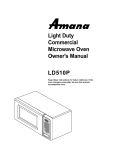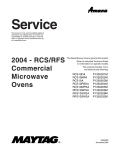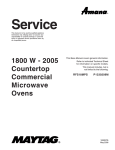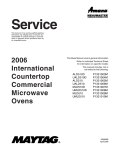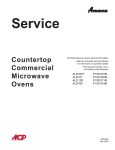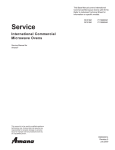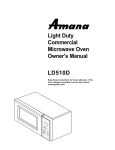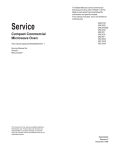Download Amana LD510D Service manual
Transcript
MENUMASTER Service COMMERCIAL MICROWAVE R OVEN This manual is to be used by qualified appliance technicians only. Maytag does not assume any responsibility for property damage or personal injury for improper service procedures done by an unqualified person. International Countertop Commercial Microwave Ovens This Base Manual covers general information. Refer to individual Technical Sheet for information on specific models. This manual includes, but is not limited to the following: LD510D LD510P DEL10D DEL10E P1329704M P1329705M P1329706M P1329707M 16022150 Revision 0 January 2003 Important Information Important Notices for Servicers and Consumers Maytag will not be responsible for personal injury or property damage from improper service procedures. Pride and workmanship go into every product to provide our customers with quality products. It is possible, however, that during its lifetime a product may require service. Products should be serviced only by a qualified service technician who is familiar with the safety procedures required in the repair and who is equipped with the proper tools, parts, testing instruments and the appropriate service information. IT IS THE TECHNICIANS RESPONSIBLITY TO REVIEW ALL APPROPRIATE SERVICE INFORMATION BEFORE BEGINNING REPAIRS. ! WARNING To avoid risk of severe personal injury or death, disconnect power before working/servicing on appliance to avoid electrical shock. To locate an authorized servicer, please consult your telephone book or the dealer from whom you purchased this product. For further assistance, please contact: Customer Service Support Center CAIR Center Web Site Telephone Number WWW.AMANA.COM ............................................ 1-800-843-0304 WWW.JENNAIR.COM .......................................... 1-800-536-6247 WWW.MAYTAG.COM .......................................... 1-800-688-9900 CAIR Center in Canada ........................................ 1-800-688-2002 Amana Canada Product ........................................ 1-866-587-2002 Recognize Safety Symbols, Words, and Labels ! DANGER DANGER—Immediate hazards which WILL result in severe personal injury or death. ! WARNING WARNING—Hazards or unsafe practices which COULD result in severe personal injury or death. ! CAUTION CAUTION—Hazards or unsafe practices which COULD result in minor personal injury, product or property damage. 2 16022150 Rev. 0 ©2003 Maytag Appliances Company Table of Contents Important Information .................................................. 2 Important Safety Information .................................... 4-8 General Information Placement of the Oven ............................................ 9 Radio Interference ................................................... 9 Earthing Instructions ............................................... 9 Microwave Oven Features ...................................... 10 Troubleshooting Procedures ................................. 11-16 Component Testing Procedures ................................ 17 Microwave Power Test Procedures Power Test (Traditional Test Method) ...................... 19 Microwave Leakage Testing Equipment ........................................................... 20 Procedure For Measuring Radiation Leakage .......... 20 Measurement With the Outer Panel Removed ......... 20 Measurement With a Fully Assembled Oven ........... 20 Record Keeping and Notification After Measurement 20 ©2003 Maytag Appliances Company Disassembly Procedures Disconnecting Wire Terminals ................................ 21 Door Assembly ..................................................... 21 Door Disassembly ................................................ 22 Outer Case .......................................................... 22 Control Panel ....................................................... 22 Controller Removal (Electronic Models)................... 23 Key Pad Removal ................................................. 23 Timer Removal (Dial Models) ................................. 23 Interlock Switches ................................................ 24 High Voltage Capacitor .......................................... 24 Diode ................................................................... 25 Transformer .......................................................... 25 Fuse Block / Filter Assembly ................................. 25 Fuse .................................................................... 25 Magnetron ............................................................ 25 Fan Motor ............................................................ 26 Cavity Thermostat ................................................. 26 Light Socket / Bulb Assembly ................................ 26 Stirrer Motor ......................................................... 26 16022150 Rev. 0 3 3 Important Safety Information 4 16022150 Rev. 0 ©2003 Maytag Appliances Company Important Safety Information ©2003 Maytag Appliances Company 16022150 Rev. 0 5 Important Safety Information 6 16022150 Rev. 0 ©2003 Maytag Appliances Company Important Safety Information ! CAUTION Read the following information to avoid possible exposure to microwave radiation: The basic design of the Amana or Menumaster microwave ovens make it an inherently safe device to both user and servicer. However, there are some precautions which should be followed when servicing the microwave oven to maintain this safety. These are as follows: 1. Always operate the unit from an adequately earthed outlet. Do not operate on a two-wire extension cord. 2. Before servicing the unit (if unit is operable), perform the microwave leakage test. 3. The oven should never be operated if the door does not fit properly against the seal, the hinges or hinge bearings are damaged or broken; the choke is damaged, (pieces missing, etc.); or any other visible damage can be noted. Check the choke area to ensure that this area is clean and free of all foreign matter. 4. If the oven operates with the door open and produces microwave energy, take the following steps. A. Tell the user not to operate the oven. B. Contact Maytag immediately. 5. Always have the oven disconnected when the outer case is removed except when making the "live" tests called for in this Service Manual. Do not reach into the equipment area while the unit is energized. Make all connections for the test and check them for tightness before plugging the cord into the outlet. 6. Always earth the capacitors on the magnetron filter box and H. V. Capacitor with an insulated-handle screwdriver before working in the high voltage area of the equipment compartment. Some types of failures will leave a charge in these capacitors and the discharge could cause a reflex action which could make you injure yourself. ©2003 Maytag Appliances Company 7. In the area of the transformer, capacitor, diode, and magnetron there is HIGH VOLTAGE. When the unit is operating, keep this area clean and free of anything which could possibly cause an arc or earthing, etc. 8. Do not for any reason defeat the interlock switches. There is no valid reason for this action at any time; nor will it be condoned by Maytag. 9. IMPORTANT: Before returning a microwave to a customer, check for proper switch interlock action. The primary and secondary switches MUST open when the door is actuated. The monitor switch MUST close at a 1/64–inch (0.5 mm) when the door is opened. 10.Before returning a microwave to a customer, verify the door spacing is reasonably uniform along the top, bottom, and sides, and that it measures 1 /64–inch (0.5 mm) or less. 11. The Amana or Menumaster microwave oven should never be operated with: • Any components removed and/or bypassed. • Any of the safety interlocks found to be defective. • Any of the seal surfaces defective, missing, or damaged. 12.To ensure that the unit does not emit excessive microwave leakage and to meet the Department of Health Human Service guidelines, check the oven for microwave leakage using Narda Model 8110 B, Holaday HI1501, HI1510, or HI1710 leakage monitor as outlined in the instructions. The maximum leakage level allowed is 4mW/cm2. 13.If servicer encounters an emission reading over 4 mw/cm2 the servicer is to cease repair and contact the Amana Service Department immediately for further direction. Amana Appliances will contact the proper Government Agency upon verification of the test results. 16022150 Rev. 0 7 Important Safety Information ! ! WARNING Precautions to be observed before and during servicing to avoid possible exposure to excessive microwave energy, or electrical shock disconnect power to oven. (A) Do not operate or allow oven to be operated with door open. (B) Make the following safety checks on all ovens to be serviced before activating the magnetron or other microwave source, and make repairs as necessary: • Interlock operation • Proper door closing • Seal and sealing surfaces (arcing, wear, and other damage) • Damage to or loosening of hinges and latches • Evidence of dropping or abuse (C) Before turning on microwave power for any service test or inspection within the microwave generating compartments, check the magnetron, waveguide or transmission line, and cavity for proper alignment, integrity, and connections. (D) Any defective or misadjusted components in the interlock, monitor, door seal, and microwave generation and transmission systems shall be repaired, replaced or adjusted by procedures described in this manual before oven is released to the consumer. (E) Check microwave leakage to verify compliance with the federal performance standard should be performed on each oven prior to release to the consumer. WARNING To avoid risk of electrical shock, personal injury or death, make sure these earthing instructions are followed. Earthing Instructions ! WARNING Do not remove earthing prong when installing earthed appliance in a home or business that does not have three wire earthing receptacle, under no condition is earthing prong to be cut off or removed. It is the personal responsibility of the consumer to contact a qualified electrician and have properly earthed three prong wall receptacle installed in accordance with appropriate electrical codes Should a two prong adapter plug be required temporarily, it is the personal responsibility of the consumer to have it replaced with properly earthed three prong receptacle or the two prong adapter properly earthed by a qualified electrician in accordance with appropriate electrical codes. Servicing of Earthed Products The standard accepted color coding for earthing wires is GREEN or GREEN WITH YELLOW STRIPE. These earth leads are NOT to be used as current carrying conductors. It is extremely important that the technician replace any and all earths prior to completion of the service call. Under no condition should earth wire be left off causing a potential hazard to technicians and consumer. Wiring Good service practice is to never route wiring over terminals and/or sharp edges. This applies to any wiring without regard to the circuit voltage. Wire insulation material and thickness is designed and regulated for electrical spacing purpose only, but cannot always be relied upon because of possible cuts and/or abrasions, which can occur during servicing. 8 16022150 Rev. 0 ©2003 Maytag Appliances Company General Information Placement of the Oven Do not install microwave next to or above source of heat, such as a deep fat fryer. This could cause the microwave to operate improperly and could shorten the life of electrical components. Install microwave on a level countertop surface. Do not block or obstruct oven filter. Allow access for cleaning. All air vents must be kept clear during cooking. If air vents are covered during operation the oven may overheat. In this case, a sensitive thermal safety device automatically turns the oven off. The oven will be inoperable until the oven has cooled sufficiently. Radio Interference Microwave oven operation may cause interference to radio, television, or similar equipment. Reduce or eliminate interference by doing the following: • Clean the door and sealing surfaces of microwave oven according to instructions in “Care and Cleaning” section. • Place radio, television, etc. as far as possible from the microwave oven. • Use a properly installed antenna on radio, television, etc. to obtain stronger signal reception. Earthing Instructions This appliance MUST be earthed. If an electrical short circuit occurs, earthing reduces the risk of electric shock by providing an escape wire for the electric current. The cord for this appliance has a earthing wire with a earthing plug. Place the plug into an outlet that is properly installed and earthed. Do not use a two–prong adapter. B ! WARNING A To avoid risk of electric shock, personal injury or death, do not alter the plug and use earthing plug properly. C D Consult a qualified electrician if you do not understand the earthing instructions or if you wonder whether the appliance is properly earthed. E Keep the electrical power cord dry and do not pinch or crush it in anyway. The wires in the power cord are colored in accordance with the following code: A–The sides of the oven should have at least enough clearance to allow air flow for ventilation. B–Allow at least 30 cm (11-13/16") of clearance around top unit. C–Allow at least 10 cm (4") of clearance and sides of unit. D–Allow at least 8 cm (3") inches from door front to edge of countertop, to avoid accidental tipping of the unit. E–Place oven on a level surface a minimum of 85 cm (33-1/2") above the floor. ©2003 Maytag Appliances Company 16022150 Rev. 0 • Green/Yellow: • Blue: • Brown: Earth Neutral Live 9 General Information Plug Receptacle Plug Receptacle 230 V / 13 AMP 230 V / 16 AMP Equipment requires a 230 VAC, 50 Hz, 13 amp power supply Equipment requires a 230 VAC, 50 Hz, 16 amp power supply Do not use a extension cord. If the product power cord is too short, have a qualified electrician install a three-prong receptacle. This unit should be plug into a separate 230 VAC / 50 Hz power supply. If other equipment is on the same circuit, an increase in cooking times may be required and fuse can be blown. Microwave Oven Description B A C D E A—Window door screen B—Spatter shields C—Control panel (Electronic or Dial) D—Door open button E—Safety door lock system 10 16022150 Rev. 0 ©2003 Maytag Appliances Company Troubleshooting Procedures When you get a complaint from customers, evaluate the complaint carefully. If the following symptoms apply, instruct the customer in the proper use of the microwave oven. This can eliminate an unnecessary service call. ! CAUTION • • • • Verify proper earthing before checking for trouble. Be careful of the high voltage circuit. Discharge the high voltage capacitor. When checking the continuity of the switches or of the high voltage transformer, disconnect one lead wire from these parts and then check continuity with the AC plug removed. To do otherwise may result in a false reading or damage to your meter. • Do not touch any part of the circuit on the controller, since static electric discharge may damage the control panel. Always touch yourself to earth while working on this panel to discharge any static charge built up in your body. Condition Microwave oven does not work. Output power is too low. Cause • Inserting multiple plugs into one outlet and using them at the same time (blown fuse or breaker). • Microwave oven plug is not inserted tightly. • Low AC input voltage. • Food temperature is too low. Sparks occur. Uneven cooking. ©2003 Maytag Appliances Company • Using metallic ware and allowing it to touch the oven wall. • Ceramic ware trimmed in gold or silver is used. Inconsistent food thickness, inconsistent fat or moisture distribution within the food products. 16022150 Rev. 0 Remedy • Avoid using other electrical appliances when you use the microwave oven. • Insert microwave oven plug securely. • Use the microwave oven at adequate line voltage. • This may not be a defect. It is possible that the food should be cooked for a longer time period. • Do not use metallic ware for cooking. • Do not use any type of cookware with metallic trimming. • Use plastic wrap or lid. • Stir once or twice while cooking soup, cocoa, milk, etc. 11 Troubleshooting Procedures Trouble 1: The following visual conditions indicate a probable failed control circuit. 1. Incomplete segments. • Segment missing. • Partial segment missing. • Digit flickering (Note: Slight flickering is normal.) 2. Colon does not turn on or blink. 3. A distinct change in the brightness of one or more numbers in display. 4. One or more digits in the display are not lighting. 5. Display indicates a number different from one touched, for example, key in 5 and 3 appears in the display. 6. Specific numbers (for example 7 or 9) will not display when key pad is touched. 7. Display does not count down with time blinking or up with clock operation. 8. Display obviously jumps in time while counting down. 9. Display counts down too fast while cooking. 10. Each indicator light does not turn on after setting cooking cycle. 11. Display time of day does not reappear when cooking is finished. Condition No input can be programmed. 12 1. Some inputs cannot be programmed. 2. Display shows a number or figure different from one touched. 3. Random programming when touching other pads. 4. Display is fixed at some figure and can not accept any input. Check Check the connection between keypad and controller. Result • Continuity Cause • Failed controller. Remedy • Replace controller. • No continuity Replace keypad and check operation. • Everything works as specified. • Loose connection. • Failed keypad. • Repair connection. • Replace keypad. • Failed controller. • Replace controller. • Still have trouble. 16022150 Rev. 0 ©2003 Maytag Appliances Company Troubleshooting Procedures (Electronic Models) Trouble 2: Oven does not operate at all, display window does not display any digits, and no input is accepted. Fuse blows. Check continuity of monitor switch with door closed. Continuity Malfunction of the monitor switch. Replace the fuse, primary, secondary, monitor switches and controller. No Continuity Replace fuse Check continuity of primary switch with door opened. Continuity Malfunction of primary switch. No Continuity Check continuity of secondary switch with door opened. Continuity Malfunction of secondary switch. No Continuity Disconnect one side of the wire lead connecting transformer to high voltage capacitor and operate the unit. Fuse blows again. Abnormal Normal Fuse does not blow. Continuity Measure resistance of high voltage capacitor. Check continuity of thermostat (cavity and magnetron). Check continuity of power cord. ©2003 Maytag Appliances Company Replace high voltage transformer. Failed high voltage capacitor. Replace high voltage capacitor. Capacitor is good, (replace fuse only). Failed thermostat. No Continuity 16022150 Rev. 0 Replace the fuse, primary, secondary, monitor switches and controller. Failed high voltage transformer. Normal No Continuity Replace the fuse, primary, secondary, monitor switches and controller. Failed power cord. Replace thermostat. Replace power cord. 13 Troubleshooting Procedures (Electronic Models) Trouble 3: Display shows all digits programmed, but does not start cooking when the START pad is pressed. Check continuity of secondary switch with door closed. Time does not count down after START pad is pressed. No Continuity Malfunction of secondary switch. Replace the secondary switch. Continuity Check connection between CN1 connector and controller. Continuity Failed controller. Replace controller. No Continuity Loose connection. Repair connection. Normal Fan motor or oven light does not operate. Check fan motor. Abnormal Failed fan motor. Replace fan motor. Check oven light. Abnormal Failed oven light. Replace oven light. Normal 14 16022150 Rev. 0 ©2003 Maytag Appliances Company Troubleshooting Procedures (Electronic Models) Trouble 4: Output performance is low. Oven operates with little or no heat. Check the power supply voltage. Lower than 90% of rated voltage. Decrease in supply voltage under load. Normal Disconnect wire leads from relay RY2 and verify on and off times. Abnormal Failed controller. Customer must contact local power company or qualified electrician. Replace controller. Normal Measure the output power. Abnormal Failed magnetron Replace magnetron. NOTE: Simple test of power output can be conducted by heating one liter of water for one minute. Refer to Amana Power Test on page 14 of this manual. ©2003 Maytag Appliances Company 16022150 Rev. 0 15 Troubleshooting Procedures (Electronic Models) Trouble 5: No microwave oscillation even when oven light and fan motor operate. No microwave oscillation. Disconnect wire leads from relay RY2 and verify continuity of the relay. No Continuity Check high voltage transformer. Abnormal Failed controller. Replace controller. Continuity Failed high voltage transformer. Replace high voltage transformer. Failed high voltage capacitor. Replace high voltage capacitor. Normal Check high voltage capacitor. Abnormal Normal Check high voltage diode. Abnormal Failed high voltage diode. Replace high voltage diode. Normal Abnormal Failed magnetron. Abnormal Failed controller. Check magnetron. Operates at full power when programmed for lower power. 16 Disconnect wire leads from relay RY2 and verify continuity of the relay. 16022150 Rev. 0 Replace magnetron. Replace controller. ©2003 Maytag Appliances Company Component Testing Procedures ! WARNING To avoid risk of electrical shock, personal injury, or death, disconnect power to oven and discharge capacitor before servicing, unless testing requires it. Illustration Component Thermal cutout Capacitor Test Disconnect all wires from TCO. Measure resistance across terminals. Magnetron TCO .......................................... Cavity TCO ................................................. Discharge Capacitors Remove wires from capacitor terminals and connect ohmmeter, set on highest resistance scale to terminals. Diode assembly Also check between each terminal and capacitor case. Discharge Capacitors Remove diode lead from capacitor and connect ohmmeter. Magnetron Reverse leads for second test. Discharge Capacitors Remove wires from magnetron and connect ohmmeter to terminals. Also check between each terminal and ground. Terminal to Case: Infinite resistance Infinite resistance should be measured in one direction and 50KΩ or more in the opposite direction. NOTE: Analog meter must contain a battery of 6 volts minimum. Between Terminals: Less than 1 Ω Each terminal to ground measures infinite resistance. Note: This test is not conclusive. If oven does not heat and all other components test good replace the magnetron and re-test. Approximately 12−14 KΩ Fan motor Measure resistance from: Terminal to terminal Remove all wires from motor. Measure resistance across coil. Approximately 350−450 Ω Discharge Capacitors Remove all wires from terminals. Measure resistance from: Primary.................................................... Secondary to transformer base plate...... Filament .................................................. Secondary Primary Interlock switches Approximately 1.4 – 2.2 Ω Approximately 90 - 110 Ω <1 Ω Disconnect wires to switch NO COM NC Secondary switch Between Terminals: Meter should momentarily deflect towards zero then return to over 5 MΩ. If no deflection occurs, or if continuous deflection occurs, replace capacitor. Remove all wires from terminals. Transformer Monitor switch Open at (145°C) 293°F and closed at (85°C) 185°F Opens at (110°C) 230°F Turntable motor Filament Primary switch Results COM NO With door open measure resistance from: COM to N.O.Primary ............................. COM to N.C.Monitor.............................. COM to N.O.Secondary ........................ Infinite Ω 0Ω Infinite Ω With door closed measure resistance from: COM to N.O.Primary ............................. COM to N.C.Monitor.............................. COM to N.O.Secondary ........................ 0Ω Infinite Ω 0Ω COM ©2003 Maytag Appliances Company 16022150 Rev. 0 17 Component Testing Procedures ! WARNING To avoid risk of electrical shock, personal injury, or death, disconnect power to oven and discharge capacitor before servicing, unless testing requires it. Illustration Component Timer 7 minute Terminal 1 to terminal 2(timer switch) ...... 2 1 4 3 Test Disconnect wire from terminals. Measure resistance of the following terminals: Terminal 3 to terminal 4 (timer motor)...... Results Approximately 22 KΩ Timer OFF infinite Ω Timer ON < 1 Ω Control CN1 Pin 1 (black) to Pin 3 (white) ....................... 1 RY2 (Cook Relay) Unplug oven and remove wire leads from RY2 terminals. Connect ohm-meter leads to terminals. Plug oven into power supply ...................... Initiate cook cycle ...................................... NOTE: RY2 should cycle when using reduced power levels. CN3 CN1 12 8 RY2 RY3 1 RY3 (Fan Relay) Unplug oven and remove wire leads from RY3 terminals. Connect ohm-meter leads to terminals. Plug oven into power supply ...................... Initiate cook cycle ...................................... NOTE: Fan relay remains energized for 60 seconds following cook cycle. Fuse block / Filter board Fuse L N L N Touch panel DEL10E 1000 WATT LD510P 1000 WATT Disconnect wire from terminals. Measure resistance of the following terminals: Verify fuse is good ..................................... Terminal L to L........................................... Terminal N to N ......................................... Continuity is indicated as 100 Ω and below. Each pad must be pressed to perform the following test. 10 PROGRAM PADS 10 PROGRAM PADS 1 2 3 4 5 6 7 8 9 10 11 0% 20% 50% 70% QTY 2X 3 COOKING STAGES 18 3 COOKING STAGES 16022150 Rev. 0 Line voltage input to control transformer. Infinite Ω <1Ω Power levels for Relay 2 Power Cycles Cycles Level On for: Off for: 20% 6 sec 16 sec 40% 10 sec 12 sec 60% 14 sec 8 sec 80% 18 sec 4 sec 100% 22 sec 0 sec Infinite Ω <1Ω <1Ω <1Ω <1Ω Pad 1 2 3 4 5 6 7 8 9 0 Hold Defrost Medium MED-HI Time Entry Stop/Reset Start X2 Trace 2&8 3&8 4&8 5&8 6&8 7&8 1&9 2&9 3&9 1&8 1 & 10 2 & 10 3 & 10 4 & 10 5 & 10 6 & 10 7 & 10 7&9 Measurement Continuity Continuity Continuity Continuity Continuity Continuity Continuity Continuity Continuity Continuity Continuity Continuity Continuity Continuity Continuity Continuity Continuity Continuity ©2003 Maytag Appliances Company Microwave Power Test Procedures ! WARNING To avoid risk of electrical shock, personal injury, or death, disconnect power to oven and discharge capacitor before servicing, unless testing requires it. Power Test (Traditional Test Method) Test equipment required is Amana power test kit R0157397 (Fahrenheit), or Menumaster power test kit M95D5 (Celsius). 1. Fill the plastic container to the 1000 ml. line with cool tap water. 2. Using the thermometer; stir the water, measure, and record the water temperature. Initial water temperature should be approximately 60°F (16°C). 3. Place container on the center of the oven shelf and heat the water for 33 seconds for ovens with more than 1550 watts or 63 seconds for ovens with less than 1550 watts. NOTE: Use a watch second hand, not the oven timer. 4. Stir the water, measure and record the temperature of the water after heating time is complete. 5. Subtract the starting water temperature (Step 2), from the ending water temperature (Step 4) to obtain the temperature rise (∆T). 6. See the Traditional Power Test Temperature Chart below. NOTES: •The IEC-705 test method requires precision measurements and equipment. It is not practical to perform the IEC test in the field. To convert the traditional power test results to the approximate IEC-705 rating, take the traditional power test results and add 100 watts per magnetron for the unit being tested. Example: 840 watts output using the traditional power test for model LD510P + 100 watts (1 magnetrons X 100 watts) 940 Approximate IEC-705 results •Always perform power test three times for accuracy, changing the water after each test is performed. •Variation or errors in the test procedure will cause a variance in the temperature rise. Additional power tests should be made if temperature rise appears marginal. •Low line voltage will cause lower temperature rise. Temperature Chart SIXTY−THREE SECONDS run time chart for units less than 1550 Watts cooking power ∆T Cooking ∆T Cooking ∆T Cooking ∆T Cooking (°F) Power Output (°F) Power Output (°C) Power Output (°C) Power Output 12 13 14 15 16 17 18 19 20 21 22 23 24 25 26 464 504 542 581 620 659 697 736 775 814 852 891 930 969 1007 27 28 29 30 31 32 33 34 35 36 37 38 39 40 7 8 9 10 11 12 13 14 490 560 630 700 770 840 910 980 15 16 17 18 19 20 21 ©2003 Maytag Appliances Company 1046 1085 1124 1162 1201 1240 1279 1317 1359 1395 1434 1472 1511 1550 16022150 Rev. 0 1050 1120 1190 1260 1330 1400 1470 19 Microwave Leakage Testing ! WARNING To avoid risk of electrical shock, personal injury, or death, disconnect power to oven and discharge capacitor before servicing, unless testing requires it. ! WARNING Check for radiation leakage after servicing. Should the leakage be more than 4mW/cm2 inform Maytag immediately. After repairing or replacing any radiation safety device, keep a written record for future reference, as required by D.H.H.S. and HEW regulations. This requirement must be strictly observed. In addition, the leakage reading must be recorded on the service repair ticket while in the customer’s home. Equipment • • • • • • • DANGER Whenever you replace the magnetron, measure for radiation leakage before the outer panel is installed and after all necessary components are replaced or adjusted. Special care should be taken in measuring around the magnetron. After all components including the outer panel are fully assembled, measure for radiation leakage around the door periphery, the door viewing window, the exhaust opening, and air inlet openings. Note before measuring - • ! Avoid contacting any high voltage components. Measurement With a Fully Assembled Oven Electromagnetic radiation monitor 600 cc glass beaker Procedure For Measuring Radiation Leakage • Measurement With the Outer Panel Removed Do not exceed meter full scale deflection. Leak monitor should initially be set to the highest scale. To prevent false readings the test probe should be held by the grip portion of the handle only. The scan speed is equal to one inch per antenna revolution or one inch per second if antenna speed is unknown. Areas to be checked are all door seal areas and any venting parts. Leakage with the outer panel removed ...4mW/cm2 or less. Leakage for fully assembled oven with door normally closed ...4mW/cm2 or less. Leakage for a fully assembly oven (before the latch switch (primary) is interrupted) while pulling the door ... 4mW/cm2 or less. Record Keeping and Notification After Measurement 1. After any adjustment or repair to a microwave oven, a leakage reading must be taken. Record this leakage reading on the repair ticket even if it is zero. 2. A copy of the repair ticket and the microwave leakage reading should be kept by the repair facility. 1. Pour 275 cc ±15 cc (9 oz ±1/2 oz) of 20°C ± 5°C (68°F ± 9°F) water in a beaker which is graduated to 600 cc and place the beaker in the center of oven. 2. Set the radiation monitor to 2450 MHz and use it following the manufacturer’s recommended test procedure to assure correct results. 3. While measuring the leakage, always use the two inch (5 cm) spacer supplied with the probe. 4. Press the start pad or turn on the timer and with the magnetron oscillating, measure the leakage by holding the probe perpendicular to the surface being measured. 20 16022150 Rev. 0 ©2003 Maytag Appliances Company Disassembly Procedures ! To avoid the risk of electrical shock, personal injury, or death, disconnect power to oven and discharge capacitors before following any disassembly procedure. WARNING High voltage is present at the high voltage terminal of the high voltage transformer during any cooking cycle. It is neither necessary or advisable to attempt measurement of the high voltage circuitry. Before touching any oven components or wiring, always unplug the oven from its power source and discharge the capacitor. All wire terminals are locking-type terminals. Proceed as follows to disconnect wire terminals: Insulated terminals: Grasp insulator pod and pull back. DO NOT PULL ON WIRE. Insulator Pod CAUTION A microwave leakage test must be performed anytime a door assembly is removed, replaced, disassembled, or adjusted for any reason. Top hinge cap Wire 2 Pull Non-insulated terminals: Use a small blade screwdriver to depress locking-tab and pull on terminal. DO NOT PULL ON WIRE. 1 Release locking-tab ! Door Removal 1. Disconnect power to oven. 2. Open oven door, remove top hinge cap, and slowly lift door to disengage the hinge pins at top and bottom. Disconnecting Wire Terminals 1 Grasp Door Assembly 3. To re-install door, place bottom pin into slot first, then align top pin. 4. Replace top hinge cap. Wire 2 Pull ©2003 Maytag Appliances Company 16022150 Rev. 0 21 Disassembly Procedures ! To avoid the risk of electrical shock, personal injury, or death, disconnect power to oven and discharge capacitors before following any disassembly procedure. WARNING Door Disassembly Outer Case 1. Disconnect power to oven. 2. Remove oven door, (see "Door Removal"). 3. Begin at the bottom of the door near hinge, insert flat blade screwdriver between choke cover and outer door panel. Gently pry upward on choke cover to release tabs. Work in clockwise direction to remove choke cover. 1. 2. 3. 4. Disconnect power to oven. Remove screws securing outer case to unit. Slide outer case towards rear of unit. Reassemble in reverse order. ! CAUTION To avoid property damage, care must be taken when prying choke cover from oven door. 4. Slide latch assembly upward and pull away from door frame to release tabs from frame. 5. Disconnect latch spring from door frame. 6. Begin at hinge side of door near bottom, insert flat blade screwdriver between door frame/choke assembly and outer door panel. Gently pry outer door panel away from door frame to release tabs. Work in clockwise direction to remove door frame. 7. Reassemble in reverse order. Control Panel Removal Choke cover 1. Disconnect power to oven and remove outer case, (see "Outer Case" procedure). 2. Disconnect and label wires from controller/timer. 3. Open oven door. 4. Remove screw securing top of control panel to cavity. Lift control panel up and out to release bottom tabs. Top hinge cap Slats Outer door panel Securing screw Latch assembly Spring Door frame/ choke assembly ! Earth screw CAUTION A microwave leakage test must be performed anytime a door assembly is removed, replaced, disassembly, or adjusted for any reason. 5. Reassemble in reverse order. NOTE: Be sure to re-install earth wire when securing control panel to cavity. NOTE: When disassembling door, use caution to prevent deformation of slats on door frame/ choke assembly. 22 16022150 Rev. 0 ©2003 Maytag Appliances Company Disassembly Procedures ! To avoid the risk of electrical shock, personal injury, or death, disconnect power to oven and discharge capacitors before following any disassembly procedure. WARNING Controller Removal (Electronic Models) Timer Removal (Dial Models) 1. Disconnect power to oven and remove outer case, (see "Outer Case" procedure). 2. Remove control panel, (see "Control Panel" section). 3. Disconnect keypad ribbon connector . 1. Disconnect power to oven and remove outer case (see "Outer Case" procedure). 2. Remove control panel, (see "Control Panel" section). 3. Remove screws securing timer to control panel. 4. Remove knob from timer. 5. Reassemble in reverse order. NOTE: Caution should be used when removing ribbon from connector. Ribbon cable has two holes to align and lock ribbon to connector. 4. Remove screws securing controller to control panel assembly. Control panel Knob Control panel Controller Timer motor Key pad Release lever Tabs Button spring Door release button Button spring Release lever Door release button All Models 5. Reassemble in reverse order. NOTE: Do not flex controller. Key Pad Removal 1. Disconnect power to oven and remove outer case, (see "Outer Case" procedure). 2. Remove control panel, (see "Control Panel" section). 3. Disconnect ribbon connector. 4. Peel off failed key pad from control panel. 6. Reassemble in reverse order. ©2003 Maytag Appliances Company Door Release Lever / Release Button / Spring 1. Disconnect power to oven and remove outer case (see "Outer Case" procedure). 2. Carefully pry tab on control panel to disengage release lever from control panel. 3. Push (4) tabs on door release button and remove button from control panel. 4. Remove spring from door release button. 5. Reassemble in reverse order. 16022150 Rev. 0 23 Disassembly Procedures ! To avoid the risk of electrical shock, personal injury, or death, disconnect power to oven and discharge capacitors before following any disassembly procedure. WARNING Interlock Switches Primary switch is operated by top latch arm. Interlock Switch Removal 1. Disconnect power to oven and remove outer case, (see "Outer Case" procedure). 2. Remove control panel, (see "Control Panel" section). 3. Test interlock switches before removing, (see testing procedures). 4. Disconnect and label wire connections. 5. Remove switches by carefully releasing locking tabs on switch bracket and tilting switches to remove from switch bracket. Push upward Secondary switch Locking Tab For door fit and switch operation, switch bracket is adjustable. 1. Disconnect power to oven and remove outer case, (see "Outer Case" procedure). 2. Loosen switch bracket mounting screws. 3. Close oven door, move switch bracket toward rear of oven until door gap is less than 1/64–inch (0.5 mm). 4. Hold switch bracket securely for proper switch operation and door fit, retighten screws. 5. Open oven door slowly, watching the switches. Verify switches release in the following order. • Primary interlock switch • Secondary interlock switch • Interlock monitor switch NOTE: Adjust the switch bracket until all switches operate in proper sequence. 6. Close the oven door slowly, watching the switches. Verify switches activate in the following order. • Interlock monitor switch • Secondary interlock switch • Primary interlock switch 7. When proper switch sequence has been achieved, tighten the switch bracket securely. Push downward slide switch Locking Tab Monitor switch ! High Voltage Capacitor NOTE: After repairing the door or the interlock system, it is necessary to check the switch continuity before operating the oven. ! CAUTION A microwave leakage test must be preformed anytime a door assembly is removed, replaced, disassembled, or adjustment of switch bracket is made. Locking Tab Push downward slide switch Primary switch CAUTION Before replacing a blown monitor fuse, test the primary interlock switch, secondary interlock switch, monitor switch, and power relay contacts for proper operation. If the monitor fuse is blown by a failed switch operation, all switches and controller must be replaced. 24 Adjusting Interlocks The interlock monitor, primary, and secondary switches act as a final safety switch, protecting the operator from microwave energy. After adjusting the interlock switch assembly, verify wires are correctly connected. High voltage capacitor should always be discharged by shorting a terminal to a chassis earth. The capacitor has a internal "shunt" resistor, but the mechanical discharge should always be performed to avoid personal injury. High Voltage Capacitor Removal 1. Disconnect power to oven and remove outer case, (see "Outer Case" procedure). 2. Discharge high voltage capacitor. 3. Remove and label wire leads from capacitor terminals. 4. Push the end of capacitor straps towards rear of oven to release strap from fan shroud. 5. Slide capacitor out of slots and remove capacitor. 6. Reassemble in reverse order. 16022150 Rev. 0 ©2003 Maytag Appliances Company Disassembly Procedures ! To avoid the risk of electrical shock, personal injury, or death, disconnect power to oven and discharge capacitors before following any disassembly procedure. WARNING Diode Magnetron 1. Disconnect power to oven and remove outer case, (see "Outer Case" procedure). 2. Discharge high voltage capacitor, (see "High Voltage Capacitor" section). 3. Disconnect diode from high voltage capacitor and remove screw securing diode to earth. 4. Reassemble in reverse order. Magnetron is mounted on the side of the cavity. Transformer 1. Disconnect power to oven and remove outer case, (see "Outer Case" section). 2. Discharge high voltage capacitor, (see "High Voltage Capacitor" section). 3. Remove filter assembly from magnetron terminals. 4. Remove air duct. 5. Remove screws securing magnetron to the wave guide. 1. Disconnect power to oven and remove outer case, (see "Outer Case" procedure). 2. Discharge high voltage capacitor, (see "High Voltage Capacitor" section). 3. Disconnect and label wire leads from transformer. 4. Remove screws securing transformer and remove. 5. Reassemble in reverse order. Waveguide Magnetron hanger Dome R.F. Gasket Fuse Block / Filter Assembly Screws 1. Disconnect power to oven and remove outer case, (see "Outer Case" section). 2. Disconnect and label wires. 3. Carefully lift rear of fuse block assembly to release assembly from locating pin. 4. Slide fuse block assembly towards front of oven to remove. 5. Reassemble in reverse order. Magnetron 6. Reassemble in reverse order. NOTE: When replacing magnetron, make sure gasket is in correct position and in good condition. ! Fuse Fuse Removal Fuse is located on the noise filter board. During replacement of magnetron, be certain the R.F. anode gasket is in place around the anode stud. 1. Disconnect power to oven and remove outer case, (see "Outer Case" section). 2. Remove and replace fuse, reassemble in reverse order. ! CAUTION Before replacing a blown monitor fuse, test the primary interlock switch, secondary interlock switch, monitor switch, and power relay contacts for proper operation. If the monitor fuse is blown by a failed switch operation, all switches and controller must be replaced. ©2003 Maytag Appliances Company CAUTION ! WARNING A microwave leakage test must be performed anytime a magnetron assembly is removed, replaced, disassembled, or adjusted for any reason. 16022150 Rev. 0 25 Disassembly Procedures ! To avoid the risk of electrical shock, personal injury, or death, disconnect power to oven and discharge capacitors before following any disassembly procedure. WARNING Fan Motor Light Socket / Bulb Assembly 1. Disconnect power to oven and remove outer case (see "Outer Case" section). 2. Discharge high voltage capacitor, (see "High Voltage Capacitor" section). 3. Remove rear air guide. 4. Remove screws securing diode to back panel. 5. Disconnect and label wires to high voltage capacitor. 6. Remove screws securing fan shroud to back panel and remove fan shroud from cavity. 7. Disconnect wires from fan motor terminals. 8. Carefully note fan blade direction and placement on motor shaft. 9. Pull fan blade from motor shaft. 10. Remove screws securing motor to shroud and remove motor. 11. Reassemble in reverse order. 1. Disconnect power to oven and remove outer case, (see "Outer Case" section). 2. Disconnect wire terminal plug. 3. Carefully bend one tab to release socket. 4. Remove light socket / bulb assembly. 5. Replace and reassemble in reverse order. Stirrer Motor 1. Disconnect power to oven. 2. Place oven on it's back. Rear air guide Fan shroud 3. Remove bottom plate cover, by cutting metal tabs NOTE: When reinstalling plate cover use screw provided. Blade 4. Disconnect wires from motor terminals. 5. Remove screws securing motor to oven cavity. Motor Cavity Thermostat Wire leads The cavity thermostat is located on top left side of cavity. Stirrer motor Thermostat is a non–resettable thermostat. 1. Disconnect power to oven and remove outer case, (see "Outer Case" section). 2. Discharge high voltage capacitor, (see "High Voltage Capacitor" section). 3. Carefully bend one tab to release thermostat. 4. Disconnect wires from oven thermostat and replace thermostat. 5. Reassemble in reverse order. 26 6. Replace and reassemble in reverse order. 16022150 Rev. 0 ©2003 Maytag Appliances Company


























